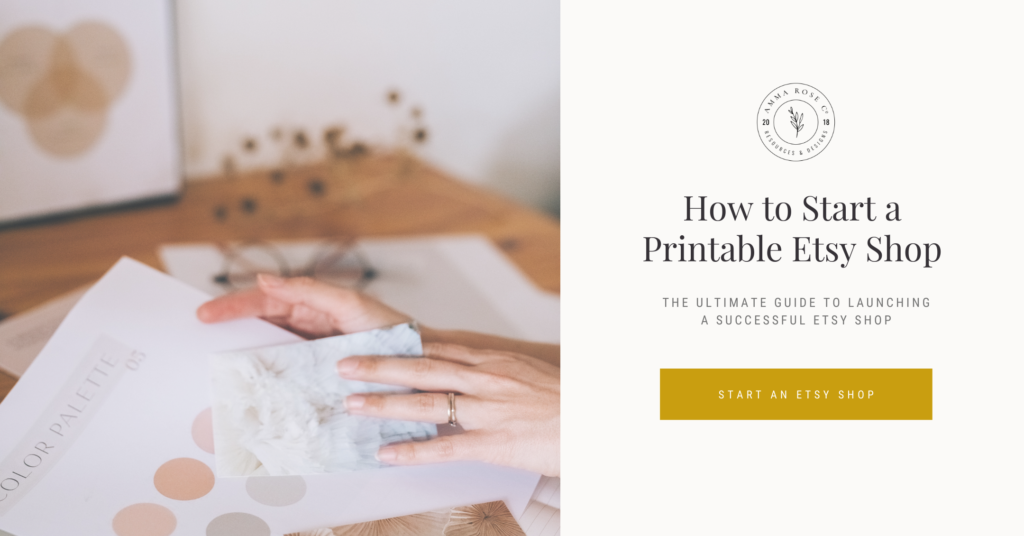
Create and Sell Digital Planners on Etsy
So, you’ve decided to start an Etsy shop and take the next step to turn your hobby into a business.
But, how exactly do you start an Etsy shop?
Building an Etsy shop may look easy from the outside, but I’m here to tell you that it is, believe it or not, a lot of hard work.
This will be one of the hardest things you’ll ever do. You are going to want to quit, you are going to question why you started, you are going to feel lonely and isolated at times and you are going to feel like no one understands what you’re doing.
You are going to be faced with the choice every day to show up or quit.
My goal is for you to step away from this complete guide and feel confident in your next steps as an Etsy seller. You’ll find a round-up of knowledge that I’ve compiled over the years that I still utilize to this day.
No matter where you’re at in your journey, even if you’re simply thinking about what could be next for you, I’m here to equip you with all the tools your toolbox can hold as you go forward!
Read through the following tutorial, which walks you through step by step on how to set up your Etsy shop from start to finish!
Related Post: How Much Does it Cost to Start a Digital Downloads Etsy Shop? (+ a Start-Up Calculator)

TABLE OF CONTENTS
What is a Printable Etsy Shop?
A printable Etsy shop is a shop dedicated to selling files that are able to be digitally downloaded with the click of a button.
Once you upload your files into Etsy, after your customer purchases that particuar item, Etsy will work it’s magic and automically deliver those files to their inbox. They’ll be able to click, download, and enjoy…all while you sit back and watch the money pour in.
The possibilities for having a printable shop on Etsy include:
- Planners, Workbooks, Guides
- Templates, Mockups
- Wall Art
- Branding Materials, Logos
- Photography
- Graphics
- Fonts
- Web Themes
And so much more!
If you can send it in a file…you can sell it on Etsy.
My Journey Selling Planners on Etsy Full-Time
So…what makes you qualified to teach me how to sell printables on Etsy?
I wanted to take a moment to show you not only the results that I’ve been so blessed to have over the past few years of managing my own Etsy shop, but also to give you an idea of the results that you could see yourself.
Without boring you with all of the minute details, I started my Etsy shop selling business planners in August/September of 2018. There were tons of reasons why I actually started, but the one that sticks out to me most is the fear of continuing down a path of “living to work”.
My story follows a pretty cliche, over-dramatic storyline of quiting my 9-to-5 and starting over from scratch, only to come out on top, happier than ever before.
It was a rocky start (I only made like $45 in my first month in business), but after getting the swing of things, I made my first $1,000 in less than 4 months of selling planners on Etsy, plus I sustained and INCREASED my income long-term. And now I’ve been getting great results for myself and others for over 2 years!
Frequently Asked Question: How much can you make selling digital downloads on Etsy? Well, check out my results below!
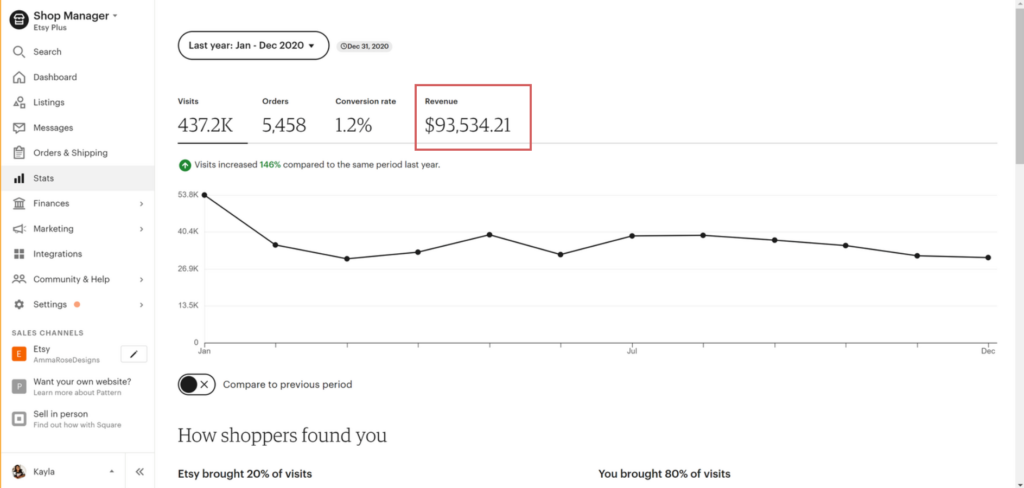
Point is, I know exactly what it takes to grow an Etsy shop the strictly sells planners and digital downloads, and now I’m going to show you how to do it too. So stick with me, because you’re going to love the outcome!
Related Post: How I Made $93K in Revenue Selling Digital Downloads on Etsy
Why You Should Start Your Etsy Shop…like yesterday!
Now more than ever, starting an online business is as easy as can be. Whether you are looking to start an eCommerce store, run an online consulting business or anything in between, there are so many reasons that online business is an important aspect of modern life.
Not only are regular businesses, such as brick and mortar & bigger corporations, increasing their online presence, but more and more people are learning how to make an income using their computers.
Here are the benefits of selling planners on Etsy:
FLEXIBILITY
Selling planners online, you won’t be tied down to a strict schedule, because your schedule is exactly what you make it. In many aspects, an Etsy Shop selling planners can run itself. With automated downloadable files that are sent directly to your customers, scheduled marketing posts, and self-operating mailing lists, once things are up and running the maintenance is relatively minimal. This means that you have the freedom to be much more flexible with your working hours, giving you more time to focus on the things you enjoy in life rather than being constantly tied to work.
PURSUIT OF HAPPINESS
No matter how obscure or out there your passions may be, you can create a space for them in an online business. Work isn’t really going to feel like work if you are doing something that you love. If you are passionate about what you do, other people are more likely to buy into it.
LOW OVERHEAD
When starting any business, you have to invest some money initially before you can start making a profit. Online businesses are fantastic because you have very low overhead! Starting a physical business can require a huge cash outlay, from rental of premises to stock and staffing, there are many costs associated with this line of work. In fact, most business start-ups need to take out a loan just to get started, putting them in debt from the get-go.
In contrast, setting up a business online can be done for very little money – in some cases you can do it for next to nothing. You do not have to rent a space, and you can use your home WiFi that you are already paying for. You are already paying your utilities, so that’s another bill you don’t have to worry about. Your main costs could include your website domain and hosting, an email marketing service, a CRM software, and Canva or Photoshop. This makes it easier to quickly get your business off the ground and running!
GREATER FINANCIAL SECURITY POTENTIAL
Your online business will be running 24 hours a day, 7 days a week even when you are not sitting at your desk performing operations. With an average 9 to 5 job, your earning ceases the moment you leave work, but with an online business, you can be making money even while you’re asleep!
Needless to say, now, more than ever, is the best time to start an Etsy shop so you can start making additional income. If one of your excuses for not starting now was the uncertainty of when you should start…the answer is ASAP!
Related Post: Is Selling Digital Planners Profitable? (+ a Monthly Profit Potential Calculator for Digital Etsy Shops)
Step One: What Will You Sell?
You have probably heard till the cows come home that you should only put your time into a business you are absolutely passionate about—your life’s mission.
While that’s the ideal scenario, it’s actually kind of like that bible verse that gets misquoted all the time (“Money is the root of all evil.”).
If you read that verse carefully, you’ll see that it’s not money that is the root of all evil: The actual verse says,
“The love of money is the root of all evil.”
meaning that those who place undue emphasis on acquiring it are likely to trip up and make horrible mistakes out of greed.
It’s the same with this whole “finding your passion” thing: It doesn’t have to be “your life’s mission” (though it’s nice if it is). All you actually need is just a business idea that excites you.
It should excite you because:
- You can help people (the right people: The ones you know you can help.)
- You know you have most of the skills it takes to make a go for it
- You feel anticipation at tackling new skills or areas of business you’ve never had the opportunity to tackle before
- You feel it will “Make a difference” – to yourself AND your clients or customers.
- It’s going to have a unique twist you just KNOW people are going to love
- It can make you serious money and build your reputation
- It will transform your customers’ and clients’ loves for the better
- It is aligned with your core beliefs and most personal values
- It will transform your life for the better!
Along with recognizing this, you’ll most likely also experience some jitters—maybe even a little fear. Relax. This is perfectly normal, experienced by ninety-something percent of all entrepreneurs in all walks of business. Let’s channel that fear into a more productive mindset and develop your business idea!
Related Post: 12 Best Selling Digital Downloads on Etsy
UNDERSTANDING WHY YOU REALLY DO WHAT YOU DO
What do super-successful small business owners all have in common?
It’s not experience.
It’s not extraordinary skills.
It’s not even a powerful drive.
Although all of these things can definitely help your business grow, they’re not a prerequisite for success. After all, no one is born with experience or skills, and plenty of successful people lack drive.
The one thing that does make a difference, though, is your “why.”
- Why did you decide to become an Etsy Seller?
- Why do you spend too many hours in front of your computer every week?
- Why do you stay up too late and get up too early, just so you can work on growing your business?
The “why” is what ultimately drives us to success, but here’s the thing: it’s different for everyone. Your why is not my why, and my why is not her why. It’s a deeply personal choice that can have great meaning…or not.
For example, a mother of small children may be saddened at the thought of sending her kids to daycare just so she can go to work to (barely) pay for it. Her big why is a drive to spend as much time with her kids as she can, while still supporting her family.
A young, fresh out of school entrepreneur might resist taking the same path her parents took, working for a corporation for 40 years, only to retire and find themselves with barely enough to live on. Instead, she dreams of having the income (and the time) to see the world while she’s still young enough to enjoy it.
So what’s your big “why”?
It might be the freedom to travel, the option to spend time with your family, the ability to take weeks off at a time to care for a sick family member, or even to earn enough money to support a charity that’s close to your heart.
Whatever it is, your “why” is the driving force behind every action you take moving forward.
IS YOUR BUSINESS IDEA SUSTAINABLE?
Mentally go through the following checks. If you don’t have an exact answer to each question, don’t sweat it! Many of these topics will be discussed in greater details later on in the article.
1.Is there a paying market for your dream?
Is there a current need for it? Is it something people always need (like plumbing or tax help) or is it a hot new trend right now with inadequate service?
2. Do you have adequate start up capital?
Here’s the good news: You don’t need to have a million dollars in your savings account. You may not even need to take out a business loan. Countless entrepreneurs have “done it” on a shoestring budget.
The great news about selling digital downloads is your start up capital should be a little as paying for your design program, a computer (if you don’t have one), and any branding materials you don’t want to create yourself.
Whether you can get started on one hundred dollars or you need one hundred thousand, make sure that it is a figure you can raise—without betting the farm on it.
3. Is your niche narrow enough?
If you are planning to serve a broad niche (example: ‘weight loss’) you will be drowned in competition. Specialize, and find a specific small segment that you can serve (example: ‘lacto-ovo-vegans’).
The topic of “target market” is something we’re going to dive deeper into in our next section.
4. Is your niche sustainable and scale-able?
Once you’ve taught people how to master the specific skill you’re offering, or you’ve sold them a life-changing product, is there someplace else for them to go within your business? Is there a natural “next step”? Can you create multiple programs and products for them?
5. Are there other’s selling in your niche?
Don’t feel like you need a super unique item that no one else is doing.
It’s okay to have some competition!
Competition means that your product idea is actually something your target market wants to buy.
Do a quick search on Etsy and review the listing results that come up and ask yourself these questions:
- How many listing results popped up? (the more results, the more competition there is)
- Are the items that are listed similar to what how you envisioned them to be?
- If so, is there a twist that you can do to stand out? Or any additional value you can provide to get your audience to come to you instead?
- What do their photos look like? What type of features are they adding to their photos? Is there anything that you would do differently?
- Are their variations or additional features that you can add to make your product stand out?
- What keywords and tags are most frequently used throughout each listing (you can find tags at the bottom of each listing)
- What are the average prices of these products? Note which listings are drastically cheaper or more expensive and ask yourselves why they are asking for that price
If you feel like you have a pretty good shot at creating this particular product and add additional value to beat out your competition, then you’ve got yourself a product you can create!
If you feel like the market is just way to saturated (way too much competition with little you can do to stand out from the crowd), niche down and get more specific!
6. Do you have clients lined up?
Do you have a waiting list? (This is one of the best ways to test whether or not you are ready.) If you do have clients lined up on an actual waiting list—what are you waiting for? Start your business!
7. Have you tested your idea?
Have you released a “preview” version or “beta” version of your new product or service package at special prices, for select people (such as members of a group you are in/you run)? What is the feedback you are getting? What
needs to be “tweaked”?
8. Do you already have a foot in the door?
Do you have credentials or experience in this that instantly qualifies you as an expert? Are you doing it or teaching it already on the side? Do you have strong network connections?
Don’t skip this phase, or impulsively rush forward with your idea before you’ve finished your research and testing. Really dig deep to come up, not just with a good business idea, but with the best, most powerful and potentially most lucrative one.
And then, when you’ve done that, dig deeper!
Step Two: Determine Your Target Market
Have you ever walked into a store and thought to yourself, “Wow, this place seems like it was made for me”? Which stores or brands seem to have that power over you?
For some, it’s like Restoration Hardware knows exactly what you’re envisioning your dream living room to look like, or that cute coffee shop down the street has the perfect vibe you’re looking for to knock out some work on your laptop, or that Target knows you can’t resist a cute day planner (even when you have ten already).
This is no coincidence.
These brands know you. They know what you like. They know your guilty pleasures…and they do a really good job of reminding you of it.
Before any of these brand began selling their top-tier product collections, over-priced trinkets, and store credit cards, they all did one thing – they identified their target market.
“Our target market is males and females, aged zero and up.”
…said no one ever!
This quote sounds silly, but this is exactly what you’re target market will be if you don’t take the time now to define who you plan on reaching out to.
NARROW YOUR NICHE
Let’s start out by defining who your ideal client is not.
Your ideal client is not a typical member of a broad generic niche.
Let’s look at an example. If you go after all people who want to lose weight, you’ll most likely attract no people who wants to lose weight: Not because you or your message isn’t good enough, but because you would have far too much competition, and your lone voice in the wilderness would be drowned out by those who are much more prominent and can afford to have bigger megaphones.
However, if you have been successful in kick-starting weight loss by eating nothing but bananas for sixty days, the right positioning can help you attract—and dominate—a much narrower sub-niche: One who will really embrace what you share.
For example, you could market specifically to:
- Those who are vegetarian
Still too broad. You could narrow that down even further to:
- Those who are fruitarian
Or even to…
- Those who are allergic to everything except bananas
This is what you have to do: Find and target a specific sector of your general niche—one that has a strong, specific need that is not being adequately met.
Anyone can find a small sub-niche in desperate need, and after careful study and getting to know the sub-niche’s members, fill that need … but this strategy seems to work much better (for you, the entrepreneur) if it’s a sub-niche you are passionate about and have extensive experience in.
Time for the first four questions:
- Do you know the sub-niche you want to serve?
- Have you checked to see that there is actually a market there?
- Have you checked to see that it is a paying market?
- Are you currently living and breathing – even already serving in – that sub-niche?
If you’ve answered ‘yes’ to all four questions, you are ideally set up to serve that niche. If you’ve answered ‘no’, you need to research further and find the right one.
If you’ve answered yes, time for one more key action: Decide whether or not you have a solution to their biggest pain point that is different, effective and easy enough to share.
DEFINE YOUR TARGET MARKET
Even if you think you already know, use the following as a checklist to double-check that you’re on target.
- What age range are you focusing on?
- How much does your ideal customer need to be making annually in order for you to charge what you need to charge?
- Where are they, and how will you reach them? Globally? North America only? Another country or continent only?
- What is the most consuming goal they have at this moment? what is the one thing above all others they need and is actively looking for help with?
- What is their biggest block?
- What is their learning preference? How do they like their information delivered – visual learner? Auditory? Knesthetic?
- What are they looking for? How does that “help” they’re looking for appear in their requests and descriptions?
These beginning steps to starting an online business are some of the most important that I encourage you to take at least a few days to sit down and think through.
I can’t tell you how many times I’ve adjusted my target market, simply because I didn’t take these steps seriously in the beginning of my journey. While this may not seem like a big deal, when you’ve already invested tons of time and money into maketing materials and designing products for a specific niche, it’s a real bummer when you have to change all of that (for the umpteenth time!).
Before you move on to the next steps, dive deep into your business idea and your target market to really solidfy your place in your chosen niche. You’ll thank me later!
Step Three: Design Your Product
One of the most important things on Etsy, and for any business, is to develop, design and create products that people actually want to buy. Many sellers feel the need to create over the top or unique products to “stand out” from the crowd, to be different, or because it’s a product that they’ve always wanted to see on the market.
Something that you should always remember and be conscious of is that you are not just creating things that you like, but you are also creating things that other people like.
If no one else likes what you make, then you are not going to sell anything.
You must constantly be thinking everyday about how you can create products that your target market wants to buy. And at the same time, you want to be passionate about what you make and sell, so you need to like what you make too.
This is where knowing your target market inside and out PLUS doing competitor research helps you and your Etsy business the most.
Always be up to date on the problems that need to be solved and the need of your ideal customer, as well as stay on stop of what’s selling on Etsy & the popular trends.
IDENTIFY A NEED
After conducting your target market research, you should have great insights into the wants and needs of your ideal customer.
What is it that she needs the most help with right now?
If your target market is working moms, she may need help with keeping up with activities, chores, at-home duties, doctor’s appointments, etc.
If your target market is photographers, she may need help with scheduling, client workflow, onboarding, marketing materials, etc.
Whatever the case may be, once you have a solid grasp on what the problem is, now it time to create the solution (i.e. your product!).
CREATE THE SOLUTION
Continuing from the examples above, the solution to your target customers problems will most likely be the product that you create. This could be in the form of a worksheet, a planner, a template, scripts, mockups, etc.
It’s your job to find out what that solution is!
DESIGN, DESIGN, DESIGN
If you’re planning on selling downloadables, you will most likely need to use a software in order to design your products.
Depending on what you decide to sell, some popular options include:
- Adobe
- Photoshop
- InDesign
- Illustrator
- Canva
- Procreate
- Corjl
- Templett
Whichever program you decide to use, it’s recommended that you become an expert in it so you can provide your best work. Consider investing into programs or courses to help you learn the ends and outs of your selected software and practice until you become a master.
As you’re designing your product, remember the purpose of your product and the problem you want it to solve as it continues to develop.
Not interested in spending hours of your time designing a planner from scratch? Check out our White Label Planners, a done-for-you planner that you can sell on your Etsy shop within minutes!

TEST YOUR PRODUCT
If there’s one thing that holds promising entrepreneurs back from launching their business, it’s this: a lack of confidence in their products. Sure, you think that new workbook or template is a great idea, but how do you know it will sell?
Imagine spending weeks or even months of time—plus the cost of document design, video editing and all the other pieces that go along with it—only to discover it’s not what your audience wants or needs. How frustrating would that be? You don’t have to leave it to chance, though. There are plenty of ways to test your idea before spending the time and energy on a full launch.
JUST ASK
This is the simplest way to get a feel for what your market needs and wants. Simply ask them. Create a survey with Survey Monkey (or even a Google form) and send it out to your mailing list. For best results, keep it short, but do ask:
- What they’re struggling with
- Their preferred learning method (video, text, audio, etc.)
- What they feel the training is worth (what would they pay)
These three pieces will tell you everything you need to know to create a program that’s practically guaranteed to sell.
LISTEN TO THEIR COMPLAINTS
If you have a community (or are part of one) of ideal customers, pay attention to what they’re asking about the most. These are the things they need help with. For example, if you’re a business coach and your Facebook group is filled with questions about running Facebook ads, then clearly there is a need for some help in that area.
STUDY YOUR COMPETITION
Hopefully you have a list of competitors and you’re reading their blogs and emails, and lurking in their Facebook groups. This is a great way to gain insight into what they’re doing—not to copy them, but to discover what’s hot right now.
Creating products in a vacuum is a great way to waste a lot of time and money on programs that won’t sell. Instead, pay attention to what your market is asking for, find out what they’re willing to pay, and delve into your competition’s offers. The information you gain from these three activities alone will give you incredible insight into your market and what they want and need, and make it easy to create your own hot-selling program.
Step Four: Setting Up Shop
Here are the basic steps of just how easy it can be to open your shop!
Keep in mind, setting up your shop is only one of the first steps to running a successful business.
The following steps are going to give you a quick overview of how to start it logistically through Etsy.com:
SIGNING UP
First, I would suggest creating an email specifically for your creative business to use for signing up.
This just keeps all of your business related emails separated from your personal emails, which seriously helps when you’ve become established and are getting upwards to 30-40 emails a day alone.
Keep it professional and use some form of the name of your Etsy shop in your email address.
For example, Cool Knits Mama would be coolknitsmama@gmail.com
Now that you have an email address for your Etsy business, go to Etsy.com and click on “Sell on Etsy”.
Sign up with your new email address.
Etsy will give you the option to sign up with your Facebook or your Google+ accounts. Again, I recommend you sticking with your business email.
Etsy also will give you suggestions for usernames based off of your own name.
This is your personal username, as the the shop owner, and not the name of your Etsy shop. If you like their suggestions – go for it! Or you can choose something you’re a little more familiar with and can remember. Just know that this is the name for your personal profile and not your shop
Shop Preferences

Next, you’ll have to fill in a little bit of information about your shop:
- Language
- Country you’re in
- Currency to be rendered
All of this is pretty much self-explanatory and you can fill it out as it pertains to you.
The last question you’ll be asked on this page is to describe how you’ll use your shop:
- Selling full-time
- Selling part-time with full-time intent
- Part-time
I chose “Part-time with Full-time Intent”, but you can choose whatever pertains to you, and you can always change it later.
Click save and continue.
Naming Your Shop
Now, you’ll be able to name your Etsy shop!
You should have a list of possible name to choose from already.
Start by plugging in your favorite choices first in the box and hitting “Check Availability”.
If it’s available, you’ve got yourself an official name!
If it’s not, move down your list until you find one that you like and also get the go-ahead from Etsy that it’s available.
Click save and continue.
Stocking Your Shop

To officially set up your Etsy shop, you’ll need to list at least one item.
You don’t have to go in and set up 10+ listings from the start. To get the hang of it, start with one and add later.
You’ll want to put the photos of your product, all of the details about the product, enter how much you’re selling the product for, the shipping info, size, weight, etc. into this section.
Click “+ Add a Listing” and add your first listing!
How You’ll Get Paid
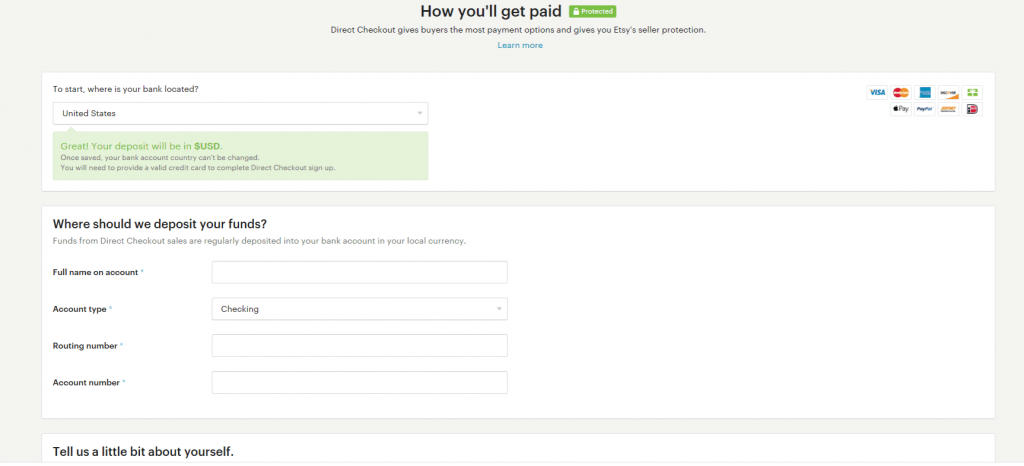
Choose the country your banking out of and Etsy will decide what currency you’ll be paid in.
Next, add your bank account information so Etsy can know where to send your money!
I recommend setting up a separate bank account for your business from the beginning, just to keep things simple.
That way you can properly track your business expenses and income in one place without it getting confusing.
Then, input all of your personal information, which Etsy uses to verify your identity.
Click save and continue.
Confirm Your Email Address
Before moving on to the next step, you have to confirm your email address.
Check your email account and click on the email Etsy has sent you.
Click “Confirm Account” and it will lease you back to the right page to continue setting up.
Set Up Billing
Etsy has a variety of fees that you’ll be responsible for as an Etsy seller:
- $0.20 listing fee
- 5% transaction fee
- 3% + $0.25 payment processing fee
These fees are charged for every transaction.
In order to pay for these fees, you’ll have to input your credit or debit card information.
Etsy will charge all of the fees for the month on the first day of the next calendar month.
Click “Open Shop”.
Your Shop Is Now Open!
After Your Shop Set-Up

Now that you’re open for business, you’ll need to follow a few more steps to get your shop officially completed.
One of the first things you’ll want to do is make your Etsy shop unique to you and your brand.
The best way to do this is by adding pictures to your Shop Banner and your Shop Profile Picture.
You should also spruce up your shop title, the About section, your featured items, shop policies, etc.
Shop Banner or Cover Photo
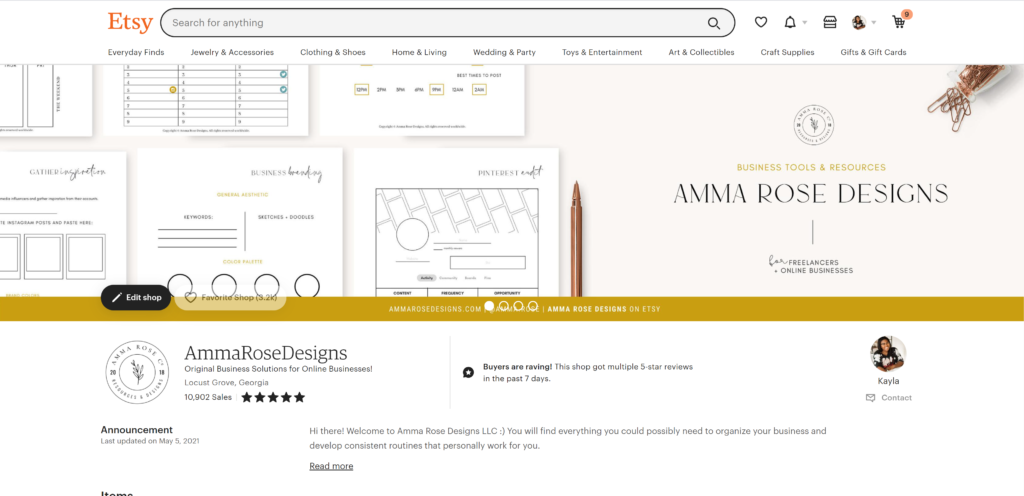
Etsy allows you to choose between a banner and a cover photo, which are two different sizes.
A banner, which is smaller, does not show up on mobile devices, while the larger cover photo does.
I personally prefer Cover Photos, but you can choose whichever you prefer.
You can use either PicMonkey, Canva, or a phone app to create your own design.
Your cover photo or banner should include:
- Your Shop Name
- Your Logo
- A Call-to-Action
- Your Social Media @ Names
- If you’re running a sale, you could indicate that here
Related Post: 3 Simple Steps to Optimizing Your Planner Etsy Shop to Convert Your Traffic into Sales
Shop Title
Your Shop Title is going to be a brief (one sentence) description of what you sell.
This your tagline and what others will see when you show up in Google searches.
Make it short and to the point!
Shop Profile Photo
Your Shop Profile Picture should be a good-quality business logo.
Make sure whichever logo you choose or create that it’s cohesive with the overall feel of your Etsy shop.
Shop Owner Picture
Your Shop Owner Picture should be a good-quality headshot of you and your smiling face!
Let your customers feel more connected to you and put a face to your shop.
Shop Announcements
Etsy gives you the ability to add little excerpts to share information from sales to update or whatever you want your customers to see as soon as they visit your shop.
Pop in and welcome your customers into your brand new shop and tell them why you’re excited to be here.
Featured Items
Featured Items will be the first listings that your customers see when they visit your shop page.
This is a great way to highlight your best sellers, and will mostly be the most-clicked listings.
Click “+ Add Listings to Your Feature Queue”, which will take you to the listings manager.
Click on the stars of each item that you want featured and they will be added.
Only four featured listings will be shown at a time.
About Your Shop

Scroll down and begin to input information all about your work process, your workspace, or anything else that gives your buyers an inside look into your business and behind-the-scenes.
You can add videos and photos, and share your story!
Shop Policies
Every single shop should have clear, in-depth shop policies.
Edit information about payment options, downloads, returning, shipping times, exchanges, and your privacy policy.
This will be the go-to section you can reference if your customers ever have an issue or are confused about something.
More Information
This section gives you the opportunity to add FAQ to answer for your future customers.
If you notice that you’ve gotten a question over and over again, add it to the FAQ section so your future customers will know the answer.
Need help with your shop branding? Take a look at these made-for-you Etsy branding templates, designed specifically for printable shops!
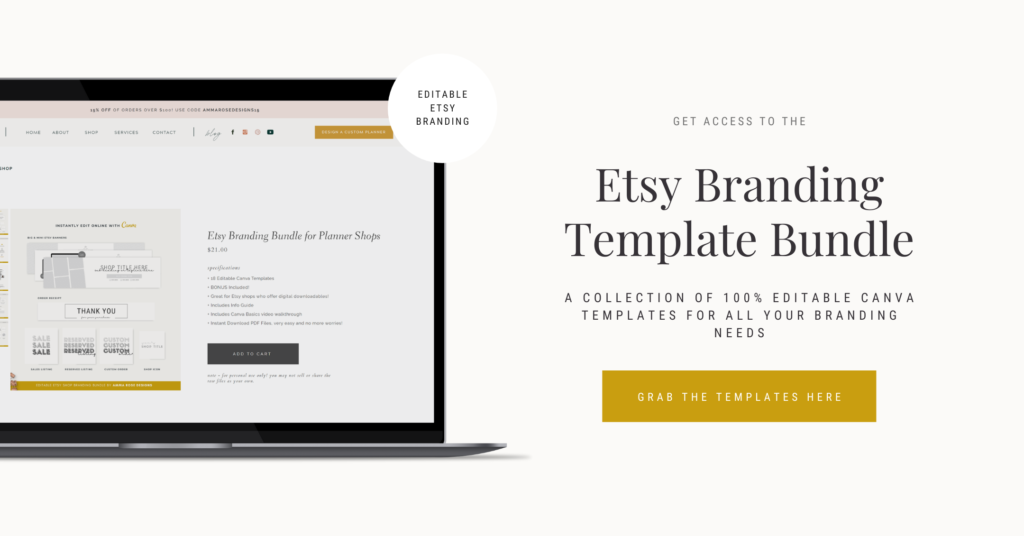
How to Start a Printable Etsy Shop
Phew!
You’ve made it to the end and can officially say you’ve started and set up an Etsy shop!
Whoo Hoo!
You’re on your way to becoming the BOSS you’ve always wanted to be.
Just remember, setting up your Etsy shop is only the beginning. The actual work comes after you set up your shop and start to get customers coming in.
I hope this tutorial helps you out!
- Where are you in the process of setting up your own Etsy shop?
- What products are you planning on selling or already selling?
- What are some of your big Etsy business goals?

Don’t forget to grab your free e-book so you don’t miss a step. Plus, get the exact tools we use to run a successful Etsy business!

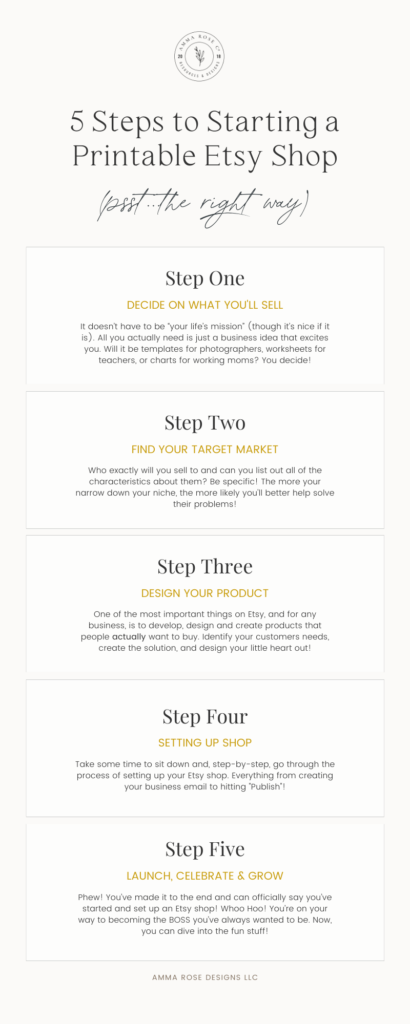

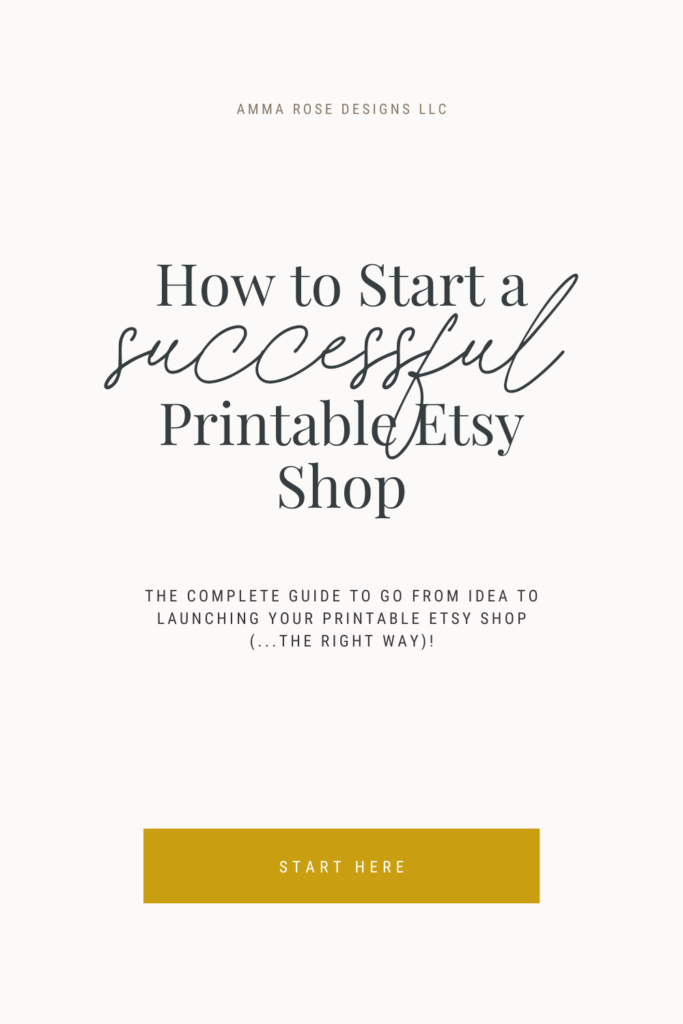
Wow! I’m speechless at the amount of detail and thought that went into this post. As someone who gets overwhelmed easily when I have to read 10 different posts to get a complete picture of a topic, this helps me tremendously to absorb everything I need to know in one take. Thank you for taking the time to do this!
I hope to be launching a Mommy Planner shop this year. I’m in the research phase now, but this post gives me the confidence to start the process of launching 🙂
Thank you so much for taking the time to reach out and comment, Elizabeth! I’m so excited to hear that you’re starting your entrepreneurship journey this year! I know you’re going to do great things. A mommy planner shop is a great niche to get into. I like that it’s niched down so you can get some nice keywords to use throughout your shop to make it easier for you to get discovered. Be sure to search around on forums and facebook groups where your target audience hangs out to get a good idea of what their pain points are. This will make it easier to develop a product line that you know will sell. Feel free to reach out if you have any questions before your launch!
Super usable! I’m amazed for so many details, I got a shop on Etsy selling Instagram Templates but it wasn’t that lucky. So now I’m starting to sell school related printables . It was good to be informed about that! Thank you so much ! Wish me luck
Hi there! Thank you so much for reading 🙂 I’m so glad to hear you’re not giving up and continuing to go for it! I can’t wait to see what you accomplish. Don’t hesitate to reach out and share your progress!